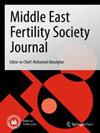Effect of different levels of serum progesterone on day of frozen ET on clinical outcome
IF 1.3
Q4 REPRODUCTIVE BIOLOGY
引用次数: 0
Abstract
Abstract Background Progesterone (P4) plays a critical role in a natural menstrual cycle. It is an essential hormone to have successful embryo implantation into the endometrium. Objective In the current study, we compared the clinical outcomes of patients with different levels of P4 on embryo transfer day and aimed to determine the optimum threshold for P4 in the luteal phase. Material and methods We performed a prospective cohort study on 100 patients who were referred to the Taleqani Infertility Treatment Institute to undergo frozen embryo transfer (FET). Endometrial preparation was programmed using an estrogen (E2) and progesterone supplement. FET was carried out 3 days after administration of the first dosage of progesterone. We measured serum progesterone levels on embryo transfer day. Clinical pregnancy was the main investigated outcome. We used a parametric receiver operating characteristic curve (ROC) to determine the best-cut points of P4 on embryo transfer day. Results Overall, the average endometrial thickness was 7.9 ± 0.2 mm. We observed no association between endometrial thickness and clinical pregnancy ( P value = 0.719). The mean number of the transferred embryos in all investigated cycles was 1.5 ± 0.5, and 80.0% of the transferred embryos were high quality (high and medium level). The average progesterone level in cycles with clinical pregnancy was 17.2 ± 3.3 ng/mL. It was only 13.4 ± 9.4 in patients without clinical pregnancy. The observed difference was statistically significant ( P value = 0.032). The estimated AUC for the drawn ROC curve was 0.71 indicating a high predictive value. Conclusion The current study demonstrated that high and low serum progesterone (P4) levels on embryo transfer day were associated with reduced clinical outcomes following blastocyst transfer during IVF/ICSI. However, more studies with large sizes are required in this regard.冰冻ET当日不同水平血清孕酮对临床预后的影响
黄体酮(P4)在自然月经周期中起着关键作用。它是胚胎成功植入子宫内膜所必需的激素。目的比较不同P4水平患者在胚胎移植当天的临床结果,旨在确定黄体期P4的最佳阈值。材料和方法我们对100名转至Taleqani不孕不育治疗研究所接受冷冻胚胎移植(FET)的患者进行了一项前瞻性队列研究。子宫内膜准备程序使用雌激素(E2)和黄体酮补充。第一次给药后3天进行FET。我们在胚胎移植当天测定血清黄体酮水平。临床妊娠是主要的调查结果。采用参数化受者工作特征曲线(ROC)确定胚胎移植日P4的最佳切割点。结果子宫内膜平均厚度为7.9±0.2 mm。子宫内膜厚度与临床妊娠无相关性(P值= 0.719)。各周期平均移植胚胎数为1.5±0.5个,80.0%为优质(高、中)移植胚胎。临床妊娠周期平均孕酮水平为17.2±3.3 ng/mL。无临床妊娠者仅为13.4±9.4。差异有统计学意义(P值= 0.032)。绘制的ROC曲线的估计AUC为0.71,具有较高的预测值。结论目前的研究表明,胚胎移植当天血清孕酮(P4)水平高低与IVF/ICSI中囊胚移植后临床预后降低有关。然而,在这方面需要更多的大规模研究。
本文章由计算机程序翻译,如有差异,请以英文原文为准。
求助全文
约1分钟内获得全文
求助全文
来源期刊

Middle East Fertility Society Journal
REPRODUCTIVE BIOLOGY-
CiteScore
2.80
自引率
0.00%
发文量
32
审稿时长
45 weeks
 求助内容:
求助内容: 应助结果提醒方式:
应助结果提醒方式:


